Java编写动态时钟的标准显示
java时间格式大全

java时间格式⼤全/*** 获取现在时间** @return返回时间类型 yyyy-MM-dd HH:mm:ss*/publicstatic Date getNowDate() {Date currentTime =new Date();SimpleDateFormat formatter =new SimpleDateFormat("yyyy-MM-dd HH:mm:ss");String dateString = formatter.format(currentTime);ParsePosition pos =new ParsePosition(8);Date currentTime_2 = formatter.parse(dateString, pos);return currentTime_2;}/*** 获取现在时间** @return返回短时间格式 yyyy-MM-dd*/publicstatic Date getNowDateShort() {Date currentTime =new Date();SimpleDateFormat formatter =new SimpleDateFormat("yyyy-MM-dd");String dateString = formatter.format(currentTime);ParsePosition pos =new ParsePosition(8);Date currentTime_2 = formatter.parse(dateString, pos);return currentTime_2;}/*** 获取现在时间** @return返回字符串格式 yyyy-MM-dd HH:mm:ss*/publicstatic String getStringDate() {Date currentTime =new Date();SimpleDateFormat formatter =new SimpleDateFormat("yyyy-MM-dd HH:mm:ss");String dateString = formatter.format(currentTime);return dateString;}/*** 获取现在时间** @return返回短时间字符串格式yyyy-MM-dd*/publicstatic String getStringDateShort() {Date currentTime =new Date();SimpleDateFormat formatter =new SimpleDateFormat("yyyy-MM-dd");String dateString = formatter.format(currentTime);return dateString;}/*** 获取时间⼩时:分;秒 HH:mm:ss** @return*/publicstatic String getTimeShort() {SimpleDateFormat formatter =new SimpleDateFormat("HH:mm:ss");Date currentTime =new Date();String dateString = formatter.format(currentTime);return dateString;** @param strDate* @return*/publicstatic Date strToDateLong(String strDate) {SimpleDateFormat formatter =new SimpleDateFormat("yyyy-MM-dd HH:mm:ss"); ParsePosition pos =new ParsePosition(0);Date strtodate = formatter.parse(strDate, pos);return strtodate;}/*** 将长时间格式时间转换为字符串 yyyy-MM-dd HH:mm:ss** @param dateDate* @return*/publicstatic String dateToStrLong(java.util.Date dateDate) {SimpleDateFormat formatter =new SimpleDateFormat("yyyy-MM-dd HH:mm:ss"); String dateString = formatter.format(dateDate);return dateString;}/*** 将短时间格式时间转换为字符串 yyyy-MM-dd** @param dateDate* @param k* @return*/publicstatic String dateToStr(java.util.Date dateDate) {SimpleDateFormat formatter =new SimpleDateFormat("yyyy-MM-dd");String dateString = formatter.format(dateDate);return dateString;}/*** 将短时间格式字符串转换为时间 yyyy-MM-dd** @param strDate* @return*/publicstatic Date strToDate(String strDate) {SimpleDateFormat formatter =new SimpleDateFormat("yyyy-MM-dd");ParsePosition pos =new ParsePosition(0);Date strtodate = formatter.parse(strDate, pos);return strtodate;}/*** 得到现在时间** @return*/publicstatic Date getNow() {Date currentTime =new Date();return currentTime;}/*** 提取⼀个⽉中的最后⼀天** @param day* @return*/return date_3_hm_date;}/*** 得到现在时间** @return字符串 yyyyMMdd HHmmss*/publicstatic String getStringToday() {Date currentTime =new Date();SimpleDateFormat formatter =new SimpleDateFormat("yyyyMMdd HHmmss");String dateString = formatter.format(currentTime);return dateString;}/*** 得到现在⼩时*/publicstatic String getHour() {Date currentTime =new Date();SimpleDateFormat formatter =new SimpleDateFormat("yyyy-MM-dd HH:mm:ss");String dateString = formatter.format(currentTime);String hour;hour = dateString.substring(11, 13);return hour;}/*** 得到现在分钟** @return*/publicstatic String getTime() {Date currentTime =new Date();SimpleDateFormat formatter =new SimpleDateFormat("yyyy-MM-dd HH:mm:ss");String dateString = formatter.format(currentTime);String min;min = dateString.substring(14, 16);return min;}/*** 根据⽤户传⼊的时间表⽰格式,返回当前时间的格式如果是yyyyMMdd,注意字母y不能⼤写。
Java万年历源代码,可显示公历、农历、系统时间、国际时间
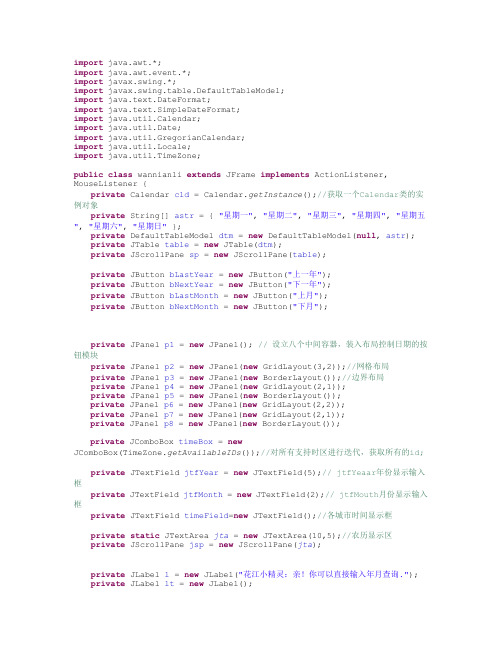
import java.awt.*;import java.awt.event.*;import javax.swing.*;import javax.swing.table.DefaultTableModel;import java.text.DateFormat;import java.text.SimpleDateFormat;import java.util.Calendar;import java.util.Date;import java.util.GregorianCalendar;import java.util.Locale;import java.util.TimeZone;public class wannianli extends JFrame implements ActionListener, MouseListener {private Calendar cld = Calendar.getInstance();//获取一个Calendar类的实例对象private String[] astr = { "星期一", "星期二", "星期三", "星期四", "星期五", "星期六", "星期日" };private DefaultTableModel dtm = new DefaultTableModel(null, astr);private JTable table = new JTable(dtm);private JScrollPane sp = new JScrollPane(table);private JButton bLastYear = new JButton("上一年");private JButton bNextYear = new JButton("下一年");private JButton bLastMonth = new JButton("上月");private JButton bNextMonth = new JButton("下月");private JPanel p1 = new JPanel(); // 设立八个中间容器,装入布局控制日期的按钮模块private JPanel p2 = new JPanel(new GridLayout(3,2));//网格布局private JPanel p3 = new JPanel(new BorderLayout());//边界布局private JPanel p4 = new JPanel(new GridLayout(2,1));private JPanel p5 = new JPanel(new BorderLayout());private JPanel p6 = new JPanel(new GridLayout(2,2));private JPanel p7 = new JPanel(new GridLayout(2,1));private JPanel p8 = new JPanel(new BorderLayout());private JComboBox timeBox = newJComboBox(TimeZone.getAvailableIDs());//对所有支持时区进行迭代,获取所有的id;private JTextField jtfYear = new JTextField(5);// jtfYeaar年份显示输入框private JTextField jtfMonth = new JTextField(2);// jtfMouth月份显示输入框private JTextField timeField=new JTextField();//各城市时间显示框private static JTextArea jta = new JTextArea(10,5);//农历显示区private JScrollPane jsp = new JScrollPane(jta);private JLabel l = new JLabel("花江小精灵:亲!你可以直接输入年月查询.");private JLabel lt = new JLabel();private JLabel ld = new JLabel();private JLabel lu = new JLabel("农历和节气");private JLabel null1=new JLabel();private int lastTime;//private String localTime = null;private String s = null;private SimpleDateFormat dateFormat=new SimpleDateFormat("yyyy年MM月dd 日 hh时mm分ss秒");public wannianli() {super("花江日历过去仅留追忆,未来刚生憧憬,唯有坚守本心,把握今天 ZYT 詹永堂 ");// 框架命名this.setDefaultCloseOperation(JFrame.EXIT_ON_CLOSE);// 窗口关闭函数this.getContentPane().setLayout(new BorderLayout(9, 10));jta.setLineWrap(true);// 长度大于分配长度时候则换行jta.setFont(new Font("黑体", Font.BOLD, 16));table.setBackground(Color.white);table.setGridColor(Color.pink);// 星期之间的网格线是灰色的table.setBackground(Color.white);table.setColumnSelectionAllowed(true);// 将table中的列设置为可选择的table.setSelectionBackground(Color.pink);// 当选定某一天时背景颜色为黑色table.setSelectionForeground(Color.GREEN);table.setBackground(new Color(184,207, 229));// 日期显示表格为浅蓝色table.setFont(new Font("黑体", Font.BOLD, 24));// 日期数字字体格式table.setRowHeight(26);// 表格的高度table.addMouseListener(this); // 鼠标监听器、lu.setFont(new Font("黑体", Font.BOLD, 22));//农历标签格氏jtfYear.addActionListener(this);// 可输入年份的文本框// 为各个按钮添加监听函数bLastYear.addActionListener(this);bNextYear.addActionListener(this);bLastMonth.addActionListener(this);bNextMonth.addActionListener(this);timeBox.addItemListener(new TimeSelectedChangedListener());// 将按钮添加到Jpane上p1.add(bLastYear);p1.add(jtfYear);// 年份输入文本框p1.add(bNextYear);p1.add(bLastMonth);p1.add(jtfMonth);p1.add(bNextMonth);p3.add(jsp, BorderLayout.SOUTH);p3.add(lu,BorderLayout.CENTER);p3.add(ld, BorderLayout.NORTH);p4.add(lt);p4.add(l);p5.add(p4, BorderLayout.SOUTH);p5.add(sp, BorderLayout.CENTER);p5.add(p1, BorderLayout.NORTH);p6.add(timeBox);p6.add(null1);p6.add(timeField);p8.add(p2,BorderLayout.CENTER);p8.add(p7,BorderLayout.SOUTH);this.getContentPane().add(p3, BorderLayout.EAST);this.getContentPane().add(p5, BorderLayout.CENTER);this.getContentPane().add(p6,BorderLayout.SOUTH);this.getContentPane().add(p8,BorderLayout.WEST);String[] strDate = DateFormat.getDateInstance().format(new Date()) .split("-");// 获取日期cld.set(Integer.parseInt(strDate[0]), Integer.parseInt(strDate[1]) - 1,0);showCalendar(Integer.parseInt(strDate[0]),Integer.parseInt(strDate[1]), cld);jtfMonth.setEditable(false);// 设置月份文本框为不可编辑jtfYear.setText(strDate[0]);jtfMonth.setText(strDate[1]);this.showTextArea(strDate[2]);ld.setFont(new Font("新宋体", Font.BOLD, 24));new Timer(lt).start();new TimeThread().start();this.setBounds(200, 200, 700, 350);this.setResizable(false);this.setVisible(true);}public void showCalendar(int localYear, int localMonth, Calendar cld) {int Days = getDaysOfMonth(localYear, localMonth) +cld.get(Calendar.DAY_OF_WEEK) -2;Object [] ai = new Object[7];lastTime = 0;for (int i = cld.get(Calendar.DAY_OF_WEEK)-1; i <= Days; i++) {ai[i%7] =String.valueOf(i-(cld.get(Calendar.DAY_OF_WEEK)-2));if (i%7 == 6){dtm.addRow(ai);ai = new Object[7];lastTime++;}}dtm.addRow(ai);}public int getDaysOfMonth(int Year, int Month) {//计算各月的天数if(Month==1||Month==3||Month==5||Month==7||Month==8||Month==10||Mont h==12){return 31;}if(Month==4||Month==6||Month==9||Month==11){return 30;}if(Year%4==0&&Year%100!=0||Year%400==0)//闰年{return 29;}else {return 28;}}public void actionPerformed(ActionEvent e)//从界面上获取年月数据{if(e.getSource() == jtfYear || e.getSource() == bLastYear || e.getSource() == bNextYear ||e.getSource() == bLastMonth || e.getSource() == bNextMonth){int m, y;try//控制输入的年份正确,异常控制{if (jtfYear.getText().length() != 4){throw new NumberFormatException();}y = Integer.parseInt(jtfYear.getText());m = Integer.parseInt(jtfMonth.getText());}catch (NumberFormatException ex){JOptionPane.showMessageDialog(this, "请输入4位0-9的数字!", "年份有误", JOptionPane.ERROR_MESSAGE);return;}ld.setText("没有选择日期");for (int i = 0; i < lastTime+1; i++){ dtm.removeRow(0);}if(e.getSource() ==bLastYear){ jtfYear.setText(String.valueOf(--y)); }if(e.getSource() ==bNextYear){jtfYear.setText(String.valueOf(++y)); }if(e.getSource() == bLastMonth){if(m == 1){jtfYear.setText(String.valueOf(--y));m = 12;jtfMonth.setText(String.valueOf(m));}else{jtfMonth.setText(String.valueOf(--m));}}if(e.getSource() == bNextMonth){if(m == 12){jtfYear.setText(String.valueOf(++y));m = 1;jtfMonth.setText(String.valueOf(m));}else{jtfMonth.setText(String.valueOf(++m));}}cld.set(y, m-1, 0);showCalendar(y, m, cld);}}public void mouseClicked(MouseEvent e){jta.setText(null);int r = table.getSelectedRow();int c = table.getSelectedColumn();if (table.getValueAt(r,c) == null){ld.setText("没有选择日期");}else{this.showTextArea(table.getValueAt(r,c));}}private void showTextArea(Object selected){ld.setText(jtfYear.getText()+"年"+jtfMonth.getText()+"月"+selected+"日");}public static void main(String[] args){JFrame.setDefaultLookAndFeelDecorated(true);JDialog.setDefaultLookAndFeelDecorated(true);new wannianli();jta.setText(today());}private void updateTimeText(String timeZoneId) {if(timeZoneId != null){TimeZone timeZone = TimeZone.getTimeZone(timeZoneId);dateFormat.setTimeZone(timeZone);Calendar calendar = Calendar.getInstance();calendar.setTimeZone(timeZone);timeField.setText(dateFormat.format(calendar.getTime()));}else{timeField.setText(null);}}private class TimeSelectedChangedListener implements ItemListener { public void itemStateChanged(ItemEvent e) {if (e.getStateChange()==ItemEvent.SELECTED) {if (e.getItem() instanceof String) {s = e.getItem().toString();}}}}private class TimeThread extends Thread{public void run(){while(true){updateTimeText(s);try{Thread.sleep(100);}catch(InterruptedException e){e.printStackTrace();}}}}class Timer extends Thread //显示系统时间{private JLabel lt;private SimpleDateFormat fy = new SimpleDateFormat(" Gyyyy.MM.dd HH:mm:ss ");public Timer(JLabel lt){this.lt=lt;}public void run(){while(true){try{lt.setText(fy.format(new Date()));this.sleep(500);}catch(InterruptedException ex){ex.printStackTrace();}}}}final private static long[] lunarInfo= new long[] { 0x04bd8, 0x04ae0, 0x0a570, 0x054d5, 0x0d260, 0x0d950, 0x16554,0x056a0, 0x09ad0, 0x055d2, 0x04ae0, 0x0a5b6, 0x0a4d0, 0x0d250, 0x1d255, 0x0b540, 0x0d6a0, 0x0ada2, 0x095b0,0x14977, 0x04970, 0x0a4b0, 0x0b4b5, 0x06a50, 0x06d40, 0x1ab54, 0x02b60, 0x09570, 0x052f2, 0x04970, 0x06566,0x0d4a0, 0x0ea50, 0x06e95, 0x05ad0, 0x02b60, 0x186e3, 0x092e0, 0x1c8d7, 0x0c950, 0x0d4a0, 0x1d8a6, 0x0b550,0x056a0, 0x1a5b4, 0x025d0, 0x092d0, 0x0d2b2, 0x0a950, 0x0b557, 0x06ca0, 0x0b550, 0x15355, 0x04da0, 0x0a5d0,0x14573, 0x052d0, 0x0a9a8, 0x0e950, 0x06aa0, 0x0aea6, 0x0ab50, 0x04b60, 0x0aae4, 0x0a570, 0x05260, 0x0f263,0x0d950, 0x05b57, 0x056a0, 0x096d0, 0x04dd5, 0x04ad0, 0x0a4d0, 0x0d4d4, 0x0d250, 0x0d558, 0x0b540, 0x0b5a0,0x195a6, 0x095b0, 0x049b0, 0x0a974, 0x0a4b0, 0x0b27a, 0x06a50, 0x06d40, 0x0af46, 0x0ab60, 0x09570, 0x04af5,0x04970, 0x064b0, 0x074a3, 0x0ea50, 0x06b58, 0x055c0, 0x0ab60, 0x096d5, 0x092e0, 0x0c960, 0x0d954, 0x0d4a0,0x0da50, 0x07552, 0x056a0, 0x0abb7, 0x025d0, 0x092d0, 0x0cab5, 0x0a950, 0x0b4a0, 0x0baa4, 0x0ad50, 0x055d9,0x04ba0, 0x0a5b0, 0x15176, 0x052b0, 0x0a930, 0x07954, 0x06aa0, 0x0ad50, 0x05b52, 0x04b60, 0x0a6e6, 0x0a4e0,0x0d260, 0x0ea65, 0x0d530, 0x05aa0, 0x076a3, 0x096d0, 0x04bd7, 0x04ad0, 0x0a4d0, 0x1d0b6, 0x0d250, 0x0d520,0x0dd45, 0x0b5a0, 0x056d0, 0x055b2, 0x049b0, 0x0a577, 0x0a4b0, 0x0aa50, 0x1b255, 0x06d20, 0x0ada0 };final private static int[] year20 = new int[] { 1, 4, 1, 2, 1, 2, 1, 1, 2, 1, 2, 1 };final private static int[] year19 = new int[] { 0, 3, 0, 1, 0, 1, 0, 0, 1, 0, 1, 0 };final private static int[] year2000 = new int[] { 0, 3, 1, 2, 1, 2, 1, 1, 2, 1, 2, 1 };public final static String[] nStr1 = new String[] { "", "正", "二", "三", "四", "五", "六", "七", "八", "九", "十", "十一","十二" };private final static String[] Gan = new String[] { "甲", "乙", "丙", "丁", "戊", "己", "庚", "辛", "壬", "癸" };private final static String[] Zhi = new String[] { "子", "丑", "寅", "卯", "辰", "巳", "午", "未", "申", "酉", "戌", "亥" };private final static String[] Animals = new String[] { "鼠", "牛", "虎", "兔", "龙", "蛇", "马", "羊", "猴", "鸡", "狗", "猪" };// 传回农历 y年的总天数final private static int lYearDays(int y) {int i, sum = 348;for (i = 0x8000; i > 0x8; i >>= 1) {if ((lunarInfo[y - 1900] & i) != 0)sum += 1;}return (sum + leapDays(y));}// 传回农历 y年闰月的天数final private static int leapDays(int y) {if (leapMonth(y) != 0) {if ((lunarInfo[y - 1900] & 0x10000) != 0)return 30;elsereturn 29;} elsereturn 0;}// 传回农历 y年闰哪个月 1-12 , 没闰传回 0final private static int leapMonth(int y) {return (int) (lunarInfo[y - 1900] & 0xf);}//传回农历 y年m月的总天数final private static int monthDays(int y, int m) {if ((lunarInfo[y - 1900] & (0x10000 >> m)) == 0)return 29;elsereturn 30;}// 传回农历 y年的生肖final public static String AnimalsYear(int y) {return Animals[(y - 4) % 12];}//传入月日的offset 传回干支,0=甲子final private static String cyclicalm(int num) {return (Gan[num % 10] + Zhi[num % 12]);}// 传入 offset 传回干支, 0=甲子final public static String cyclical(int y) {int num = y - 1900 + 36;return (cyclicalm(num));}// 传出农历.year0 .month1 .day2 .yearCyl3 .monCyl4 .dayCyl5 .isLeap6final private long[] Lunar(int y, int m) {long[] nongDate = new long[7];int i = 0, temp = 0, leap = 0;Date baseDate = new GregorianCalendar(1900 + 1900, 1,31).getTime();Date objDate = new GregorianCalendar(y + 1900, m, 1).getTime();long offset = (objDate.getTime() - baseDate.getTime()) / 86400000L;if (y < 2000)offset += year19[m - 1];if (y > 2000)offset += year20[m - 1];if (y == 2000)offset += year2000[m - 1];nongDate[5] = offset + 40;nongDate[4] = 14;for (i = 1900; i < 2050 && offset > 0; i++) {temp = lYearDays(i);offset -= temp;nongDate[4] += 12;}if (offset < 0) {offset += temp;i--;nongDate[4] -= 12;}nongDate[0] = i;nongDate[3] = i - 1864;leap = leapMonth(i); // 闰哪个月nongDate[6] = 0;for (i = 1; i < 13 && offset > 0; i++) {// 闰月if (leap > 0 && i == (leap + 1) && nongDate[6] == 0) { --i;nongDate[6] = 1;temp = leapDays((int) nongDate[0]);} else {temp = monthDays((int) nongDate[0], i);}// 解除闰月if (nongDate[6] == 1 && i == (leap + 1))nongDate[6] = 0;offset -= temp;if (nongDate[6] == 0)nongDate[4]++;}if (offset == 0 && leap > 0 && i == leap + 1) {if (nongDate[6] == 1) {nongDate[6] = 0;} else {nongDate[6] = 1;--i;--nongDate[4];}}if (offset < 0) {offset += temp;--i;--nongDate[4];}nongDate[1] = i;nongDate[2] = offset + 1;return nongDate;}// 传出y年m月d日对应的农历.year0 .month1 .day2 .yearCyl3 .monCyl4 .dayCyl5 .isLeap6final public static long[] calElement(int y, int m, int d) {long[] nongDate = new long[7];int i = 0, temp = 0, leap = 0;Date baseDate = new GregorianCalendar(0 + 1900, 0, 31).getTime();Date objDate = new GregorianCalendar(y, m - 1, d).getTime();long offset = (objDate.getTime() - baseDate.getTime()) / 86400000L;nongDate[5] = offset + 40;nongDate[4] = 14;for (i = 1900; i < 2050 && offset > 0; i++) {temp = lYearDays(i);offset -= temp;nongDate[4] += 12;}if (offset < 0) {offset += temp;i--;nongDate[4] -= 12;}nongDate[0] = i;nongDate[3] = i - 1864;leap = leapMonth(i); // 闰哪个月nongDate[6] = 0;for (i = 1; i < 13 && offset > 0; i++) {// 闰月if (leap > 0 && i == (leap + 1) && nongDate[6] == 0) { --i;nongDate[6] = 1;temp = leapDays((int) nongDate[0]);} else {temp = monthDays((int) nongDate[0], i);}// 解除闰月if (nongDate[6] == 1 && i == (leap + 1))nongDate[6] = 0;offset -= temp;if (nongDate[6] == 0)nongDate[4]++;}if (offset == 0 && leap > 0 && i == leap + 1) { if (nongDate[6] == 1) {nongDate[6] = 0;} else {nongDate[6] = 1;--i;--nongDate[4];}}if (offset < 0) {offset += temp;--i;--nongDate[4];}nongDate[1] = i;nongDate[2] = offset + 1;return nongDate;}public final static String getChinaDate(int day) { String a = "";if (day == 10)return"初十";if (day == 20)return"二十";if (day == 30)return"三十";int two = (int) ((day) / 10);if (two == 0)a = "初";if (two == 1)a = "十";if (two == 2)a = "廿";if (two == 3)a = "三";int one = (int) (day % 10);switch (one) {case 1:a += "一";break;case 2:a += "二";break;case 3:a += "三";break;case 4:a += "四";break;case 5:a += "五";break;case 6:a += "六";break;case 7:a += "七";break;case 8:a += "八";break;case 9:a += "九";break;}return a;}public static String today() {Calendar today = Calendar.getInstance(Locale.SIMPLIFIED_CHINESE);int year = today.get(Calendar.YEAR);int month = today.get(Calendar.MONTH) + 1;int date = today.get(Calendar.DATE);long[] l = calElement(year, month, date);StringBuffer sToday = new StringBuffer();try {sToday.append(sdf.format(today.getTime()));sToday.append(" \n");sToday.append(" \n");sToday.append(" \n");sToday.append(" 农历");sToday.append(cyclical(year));sToday.append('(');sToday.append(AnimalsYear(year));sToday.append(")年");sToday.append(" \n");sToday.append(" ");sToday.append(nStr1[(int) l[1]]);sToday.append("月");sToday.append(getChinaDate((int) (l[2])));return sToday.toString();} finally {sToday = null;}}private static SimpleDateFormat sdf = new SimpleDateFormat("yyyy 年M月d日 EEEEE");public void mouseEntered(MouseEvent e) {}public void mouseExited(MouseEvent e) {}public void mousePressed(MouseEvent e) {}public void mouseReleased(MouseEvent e) { }}。
JSP实时显示当前系统时间的四种方式示例解析
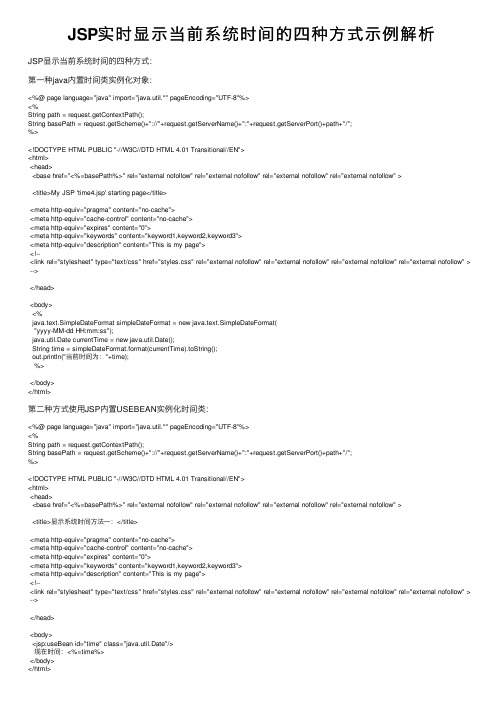
<meta http-equiv="pragma" content="no-cache"> <meta http-equiv="cache-control" content="no-cache"> <meta http-equiv="expires" content="0"> <meta http-equiv="keywords" content="keyword1,keyword2,keyword3"> <meta http-equiv="description" content="This is my page"> <!-<link rel="stylesheet" type="text/css" href="styles.css" rel="external nofollow" rel="external nofollow" rel="external nofollow" rel="external nofollow" > -->
</head>
<body> <jsp:useBean id="time" type="java.io.Serializable" beanName="java.util.Date"/> 现在时间:<%=time%>
在Android Studio中开发一个简单的时钟应用
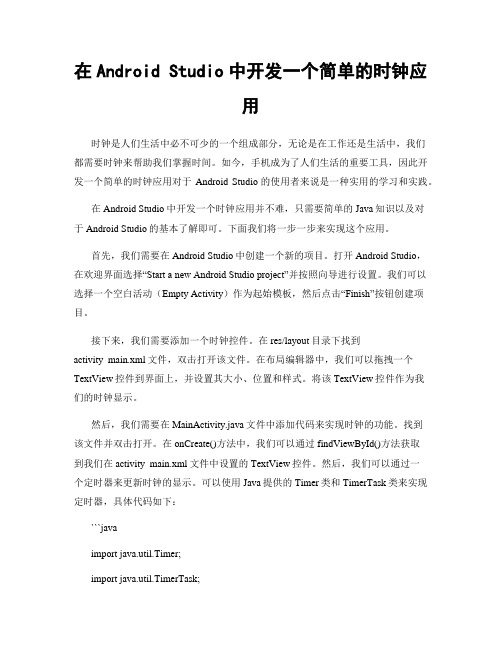
在Android Studio中开发一个简单的时钟应用时钟是人们生活中必不可少的一个组成部分,无论是在工作还是生活中,我们都需要时钟来帮助我们掌握时间。
如今,手机成为了人们生活的重要工具,因此开发一个简单的时钟应用对于Android Studio的使用者来说是一种实用的学习和实践。
在Android Studio中开发一个时钟应用并不难,只需要简单的Java知识以及对于Android Studio的基本了解即可。
下面我们将一步一步来实现这个应用。
首先,我们需要在Android Studio中创建一个新的项目。
打开Android Studio,在欢迎界面选择“Start a new Android Studio project”并按照向导进行设置。
我们可以选择一个空白活动(Empty Activity)作为起始模板,然后点击“Finish”按钮创建项目。
接下来,我们需要添加一个时钟控件。
在res/layout目录下找到activity_main.xml文件,双击打开该文件。
在布局编辑器中,我们可以拖拽一个TextView控件到界面上,并设置其大小、位置和样式。
将该TextView控件作为我们的时钟显示。
然后,我们需要在MainActivity.java文件中添加代码来实现时钟的功能。
找到该文件并双击打开。
在onCreate()方法中,我们可以通过findViewById()方法获取到我们在activity_main.xml文件中设置的TextView控件。
然后,我们可以通过一个定时器来更新时钟的显示。
可以使用Java提供的Timer类和TimerTask类来实现定时器,具体代码如下:```javaimport java.util.Timer;import java.util.TimerTask;public class MainActivity extends AppCompatActivity {TextView clockTextView;@Overrideprotected void onCreate(Bundle savedInstanceState) {super.onCreate(savedInstanceState);setContentView(yout.activity_main);clockTextView = findViewById(R.id.clockTextView); Timer timer = new Timer();TimerTask timerTask = new TimerTask() {@Overridepublic void run() {updateTime();}};timer.schedule(timerTask, 0, 1000);}private void updateTime() {runOnUiThread(new Runnable() {@Overridepublic void run() {SimpleDateFormat simpleDateFormat = newSimpleDateFormat("HH:mm:ss");clockTextView.setText(simpleDateFormat.format(new Date()));}});}}```在上述代码中,我们首先获取到了我们在布局文件中设置的TextView控件并保存在clockTextView变量中。
java钟表课程设计
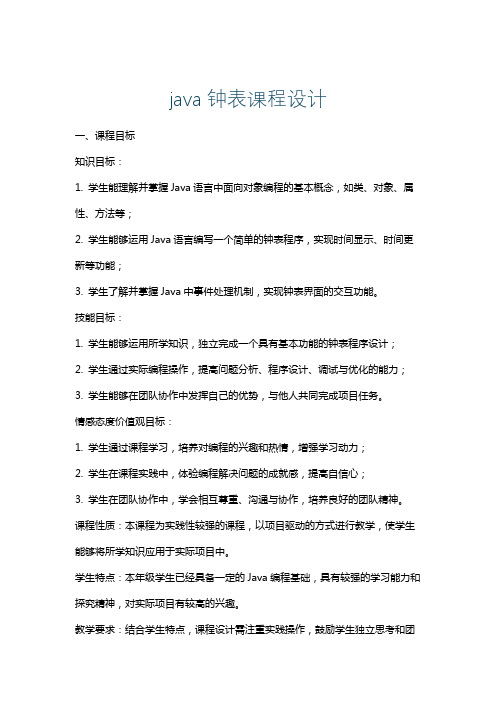
java钟表课程设计一、课程目标知识目标:1. 学生能理解并掌握Java语言中面向对象编程的基本概念,如类、对象、属性、方法等;2. 学生能够运用Java语言编写一个简单的钟表程序,实现时间显示、时间更新等功能;3. 学生了解并掌握Java中事件处理机制,实现钟表界面的交互功能。
技能目标:1. 学生能够运用所学知识,独立完成一个具有基本功能的钟表程序设计;2. 学生通过实际编程操作,提高问题分析、程序设计、调试与优化的能力;3. 学生能够在团队协作中发挥自己的优势,与他人共同完成项目任务。
情感态度价值观目标:1. 学生通过课程学习,培养对编程的兴趣和热情,增强学习动力;2. 学生在课程实践中,体验编程解决问题的成就感,提高自信心;3. 学生在团队协作中,学会相互尊重、沟通与协作,培养良好的团队精神。
课程性质:本课程为实践性较强的课程,以项目驱动的方式进行教学,使学生能够将所学知识应用于实际项目中。
学生特点:本年级学生已经具备一定的Java编程基础,具有较强的学习能力和探究精神,对实际项目有较高的兴趣。
教学要求:结合学生特点,课程设计需注重实践操作,鼓励学生独立思考和团队协作,提高编程能力和解决问题的能力。
通过分解课程目标为具体学习成果,为后续教学设计和评估提供依据。
二、教学内容1. 面向对象编程基础:- 类与对象的概念及其关系- 方法定义与调用- 属性的定义与使用2. Java界面设计:- Java Swing图形用户界面- 常用组件的使用(如按钮、文本框等)- 布局管理器的应用3. 事件处理机制:- 事件的概念与分类- 事件监听器与事件处理方法- 常用事件处理机制的应用4. 钟表程序设计:- 钟表界面设计- 时间更新功能的实现- 闹钟功能的添加与实现5. 项目实践与团队协作:- 学生分组,明确项目任务与分工- 各组制定项目计划,进行项目实践- 项目成果展示与评价教学内容安排与进度:第一周:面向对象编程基础,类与对象的概念,方法的定义与调用第二周:Java界面设计,Swing组件的使用,布局管理器的应用第三周:事件处理机制,编写简单的事件处理程序第四周:钟表程序设计,实现时间显示与更新,添加闹钟功能第五周:项目实践与团队协作,完成项目任务,进行成果展示与评价教材章节关联:《Java程序设计》第四章:面向对象编程基础第五章:Java图形用户界面设计第六章:事件处理三、教学方法1. 讲授法:- 对于面向对象编程基础、Java界面设计、事件处理机制等理论知识,采用讲授法进行教学,为学生提供清晰的知识框架和概念体系。
数字时钟代码

数字时钟代码1. 介绍数字时钟是一种常见的显示时间的装置,它通过数字显示屏显示当前的小时和分钟。
本文档将介绍如何编写一个简单的数字时钟代码。
2. 代码实现以下是一个基本的数字时钟代码实现示例:import timewhile True:current_time = time.localtime()hour = str(current_time.tm_hour).zfill(2)minute = str(current_time.tm_min).zfill(2)second = str(current_time.tm_sec).zfill(2)clock_display = f"{hour}:{minute}:{second}"print(clock_display, end="\r")time.sleep(1)代码说明:- `time.localtime()` 函数返回当前时间的结构化对象,包括小时、分钟和秒等信息。
- `str(current_time.tm_hour).zfill(2)` 将小时转换为字符串,并使用 `zfill()` 方法填充到两位数。
- `str(current_time.tm_min).zfill(2)` 和`str(current_time.tm_sec).zfill(2)` 同理处理分钟和秒。
- 使用 f-string 格式化字符串 `clock_display`,将小时、分钟和秒显示为 `` 的形式。
- `print(clock_display, end="\r")` 使用 `\r` 实现覆盖打印,使得时钟在同一行连续显示。
- `time.sleep(1)` 让程序每隔一秒更新一次时间。
请注意,上述代码需要在支持 Python 的环境中运行。
3. 结束语通过以上的代码实现,我们可以编写一个简单的数字时钟。
时钟程序设计
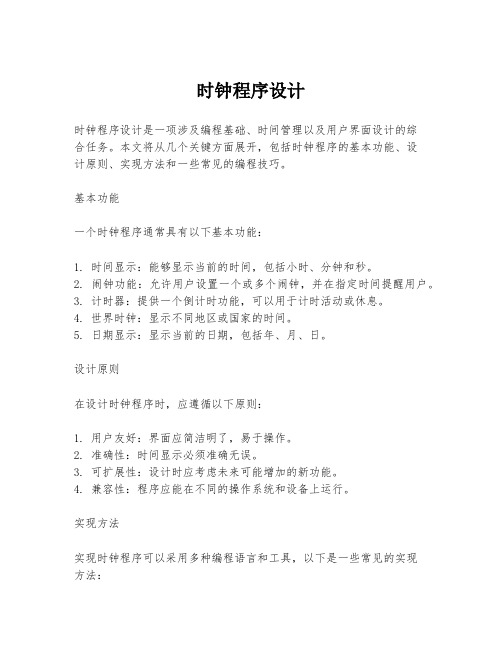
时钟程序设计时钟程序设计是一项涉及编程基础、时间管理以及用户界面设计的综合任务。
本文将从几个关键方面展开,包括时钟程序的基本功能、设计原则、实现方法和一些常见的编程技巧。
基本功能一个时钟程序通常具有以下基本功能:1. 时间显示:能够显示当前的时间,包括小时、分钟和秒。
2. 闹钟功能:允许用户设置一个或多个闹钟,并在指定时间提醒用户。
3. 计时器:提供一个倒计时功能,可以用于计时活动或休息。
4. 世界时钟:显示不同地区或国家的时间。
5. 日期显示:显示当前的日期,包括年、月、日。
设计原则在设计时钟程序时,应遵循以下原则:1. 用户友好:界面应简洁明了,易于操作。
2. 准确性:时间显示必须准确无误。
3. 可扩展性:设计时应考虑未来可能增加的新功能。
4. 兼容性:程序应能在不同的操作系统和设备上运行。
实现方法实现时钟程序可以采用多种编程语言和工具,以下是一些常见的实现方法:1. 桌面应用:使用C++、Java或Python等语言,结合图形用户界面库如Qt、Swing或Tkinter。
2. 网页应用:使用HTML、CSS和JavaScript,结合前端框架如React 或Vue.js。
3. 移动应用:使用Swift或Kotlin为iOS或Android开发应用。
4. 命令行程序:使用任何支持标准输入输出的编程语言,如Python 或C。
编程技巧1. 时间获取:大多数编程语言都提供了获取当前时间的函数,如Python中的`datetime.now()`。
2. 定时器:使用循环或专门的定时器函数来更新时间显示,如JavaScript中的`setInterval`。
3. 闹钟逻辑:设计一个闹钟系统需要考虑时间比较和事件触发,可以使用条件判断和循环结构。
4. 用户界面:设计直观的界面,使用户能够轻松设置时间和日期。
5. 错误处理:确保程序能够处理无效的输入和异常情况。
示例代码(Python)以下是一个简单的Python时钟程序示例,使用标准库`datetime`来获取和显示时间:```pythonimport timefrom datetime import datetimedef display_time():while True:now = datetime.now()current_time = now.strftime("%H:%M:%S")print(current_time)time.sleep(1)if __name__ == "__main__":display_time()```结语设计一个时钟程序是一个有趣且具有教育意义的项目,它不仅能够帮助你理解编程的基本概念,还能够提高你对时间管理和用户界面设计的认识。
java 中国标准时间
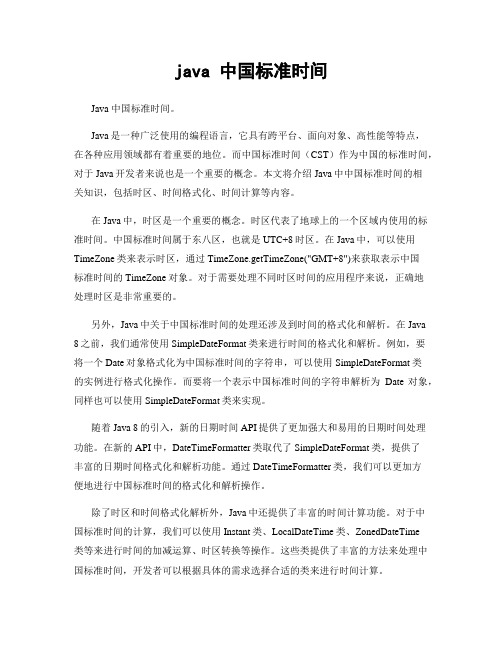
java 中国标准时间Java 中国标准时间。
Java是一种广泛使用的编程语言,它具有跨平台、面向对象、高性能等特点,在各种应用领域都有着重要的地位。
而中国标准时间(CST)作为中国的标准时间,对于Java开发者来说也是一个重要的概念。
本文将介绍Java中中国标准时间的相关知识,包括时区、时间格式化、时间计算等内容。
在Java中,时区是一个重要的概念。
时区代表了地球上的一个区域内使用的标准时间。
中国标准时间属于东八区,也就是UTC+8时区。
在Java中,可以使用TimeZone类来表示时区,通过TimeZone.getTimeZone("GMT+8")来获取表示中国标准时间的TimeZone对象。
对于需要处理不同时区时间的应用程序来说,正确地处理时区是非常重要的。
另外,Java中关于中国标准时间的处理还涉及到时间的格式化和解析。
在Java 8之前,我们通常使用SimpleDateFormat类来进行时间的格式化和解析。
例如,要将一个Date对象格式化为中国标准时间的字符串,可以使用SimpleDateFormat类的实例进行格式化操作。
而要将一个表示中国标准时间的字符串解析为Date对象,同样也可以使用SimpleDateFormat类来实现。
随着Java 8的引入,新的日期时间API提供了更加强大和易用的日期时间处理功能。
在新的API中,DateTimeFormatter类取代了SimpleDateFormat类,提供了丰富的日期时间格式化和解析功能。
通过DateTimeFormatter类,我们可以更加方便地进行中国标准时间的格式化和解析操作。
除了时区和时间格式化解析外,Java中还提供了丰富的时间计算功能。
对于中国标准时间的计算,我们可以使用Instant类、LocalDateTime类、ZonedDateTime类等来进行时间的加减运算、时区转换等操作。
这些类提供了丰富的方法来处理中国标准时间,开发者可以根据具体的需求选择合适的类来进行时间计算。
JAVA编程题全集(100题及答案)
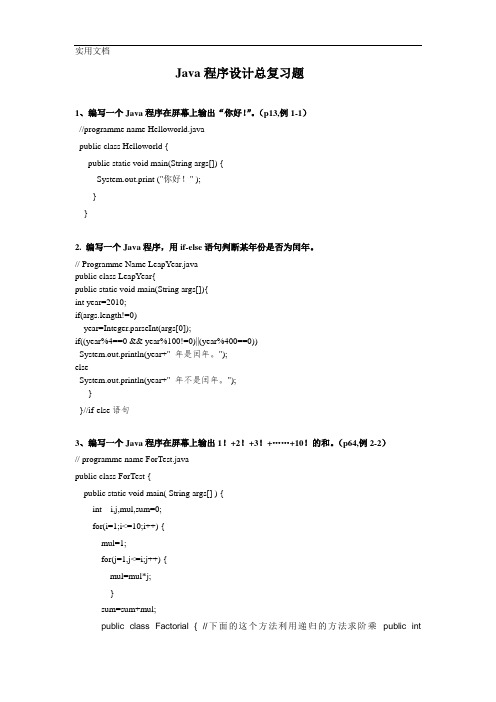
Java程序设计总复习题1、编写一个Java程序在屏幕上输出“你好!”。
(p13,例1-1)//programme name Helloworld.javapublic class Helloworld {public static void main(String args[]) {System.out.print ("你好!" );}}2. 编写一个Java程序,用if-else语句判断某年份是否为闰年。
// Programme Name LeapYear.javapublic class LeapYear{public static void main(String args[]){int year=2010;if(args.length!=0)year=Integer.parseInt(args[0]);if((year%4==0 && year%100!=0)||(year%400==0))System.out.println(year+" 年是闰年。
");elseSystem.out.println(year+" 年不是闰年。
");}}//if-else语句3、编写一个Java程序在屏幕上输出1!+2!+3!+……+10!的和。
(p64,例2-2)// programme name ForTest.javapublic class ForTest {public static void main( String args[] ) {int i,j,mul,sum=0;for(i=1;i<=10;i++) {mul=1;for(j=1,j<=i;j++) {mul=mul*j;}sum=sum+mul;public class Factorial { //下面的这个方法利用递归的方法求阶乘public intgetFac(int m) { if(m==1) { return 1; } else { return m*getFac(m-1); } } public static void main(String args[]) { Factorial fac=new Factorial(); //System.out.println(fac.getFac(4)); int sum=0; for(int i=1;i<=10;i++) { sum+=fac.getFac(i); } System.out.println("1到10的阶乘的和是:"+sum); } }}System.out.println(“1!+2!+3!+……+10!= ”+sum);}}4. (1)编写一个圆类Circle,该类拥有:①一个成员变量Radius(私有,浮点型);// 存放圆的半径;②两个构造方法Circle( ) // 将半径设为0Circle(double r ) //创建Circle对象时将半径初始化为r③三个成员方法double getArea( ) //获取圆的面积double getPerimeter( ) //获取圆的周长void show( ) //将圆的半径、周长、面积输出到屏幕(2)编写一个圆柱体类Cylinder,它继承于上面的Circle类。
Java数字时钟(简单的桌面应用)
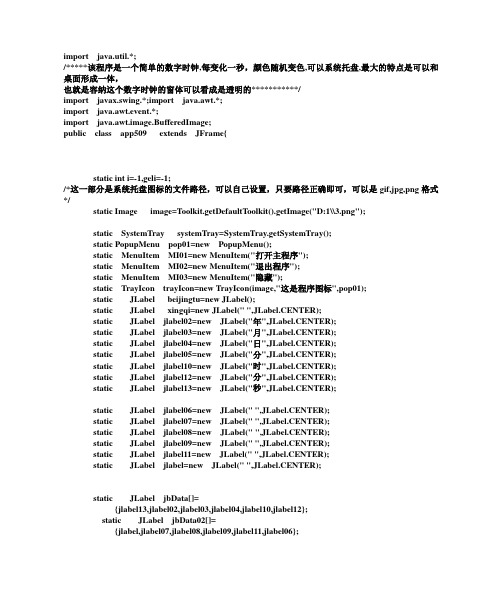
import java.util.*;/*****该程序是一个简单的数字时钟,每变化一秒,颜色随机变色,可以系统托盘,最大的特点是可以和桌面形成一体,也就是容纳这个数字时钟的窗体可以看成是透明的***********/import javax.swing.*;import java.awt.*;import java.awt.event.*;import java.awt.image.BufferedImage;public class app509 extends JFrame{static int i=-1,geli=-1;/*这一部分是系统托盘图标的文件路径,可以自己设置,只要路径正确即可,可以是gif,jpg,png格式*/static Image image=Toolkit.getDefaultToolkit().getImage("D:1\\3.png");static SystemTray systemTray=SystemTray.getSystemTray();static PopupMenu pop01=new PopupMenu();static MenuItem MI01=new MenuItem("打开主程序");static MenuItem MI02=new MenuItem("退出程序");static MenuItem MI03=new MenuItem("隐藏");static TrayIcon trayIcon=new TrayIcon(image,"这是程序图标",pop01);static JLabel beijingtu=new JLabel();static JLabel xingqi=new JLabel(" ",JLabel.CENTER);static JLabel jlabel02=new JLabel("年",JLabel.CENTER);static JLabel jlabel03=new JLabel("月",JLabel.CENTER);static JLabel jlabel04=new JLabel("日",JLabel.CENTER);static JLabel jlabel05=new JLabel("分",JLabel.CENTER);static JLabel jlabel10=new JLabel("时",JLabel.CENTER);static JLabel jlabel12=new JLabel("分",JLabel.CENTER);static JLabel jlabel13=new JLabel("秒",JLabel.CENTER);static JLabel jlabel06=new JLabel(" ",JLabel.CENTER);static JLabel jlabel07=new JLabel(" ",JLabel.CENTER);static JLabel jlabel08=new JLabel(" ",JLabel.CENTER);static JLabel jlabel09=new JLabel(" ",JLabel.CENTER);static JLabel jlabel11=new JLabel(" ",JLabel.CENTER);static JLabel jlabel=new JLabel(" ",JLabel.CENTER);static JLabel jbData[]={jlabel13,jlabel02,jlabel03,jlabel04,jlabel10,jlabel12};static JLabel jbData02[]={jlabel,jlabel07,jlabel08,jlabel09,jlabel11,jlabel06};static int mill=0;static int minute=0;static int hour=0;static int day=0;static int month=0;static int year=0;static int week;static int zuobiaoX,zuobiaoY;static JFrame JF01=new JFrame();static JDialog JF=new JDialog(JF01," ");static Robot robot;static BufferedImage image1;static Rectangle rec;static class mouseListener extends MouseAdapter{public void mouseClicked(MouseEvent a){if(a.getSource()==trayIcon){if(a.getClickCount()==2){i++;if(i%2==1){geli++;if(geli%2==1){image1=robot.createScreenCapture(rec);beijingtu.setIcon(new ImageIcon(image1));JF.setBounds(0,0,120,560);JF.setVisible(true);}}else{JF.setBounds(0,0,400,1);}}}}public void mouseEntered(MouseEvent a){if(a.getSource()==JF){image1=robot.createScreenCapture(rec);beijingtu.setIcon(new ImageIcon(image1));JF.setBounds(0,0,120,560);JF.setVisible(true);}}public void mouseExited(MouseEvent a){if(a.getSource()==JF){JF.setBounds(0,0,400,1);}}}public static void main(String args[]) throws Exception{trayIcon.addMouseListener(new mouseListener());rec=new Rectangle(0,0,(int)Toolkit.getDefaultToolkit().getScreenSize().getWidth(),(int)Toolkit.getDefaultToolkit().getScreenSize().getHeight());try{robot=new Robot(); }catch(Exception b){}image1=robot.createScreenCapture(rec);beijingtu.setIcon(new ImageIcon(image1));MI01.addActionListener(new ActionListener(){public void actionPerformed(ActionEvent a){Image1=robot.createScreenCapture(rec);beijingtu.setIcon(new ImageIcon(image1));JF.setBounds(0,0,120,560);JF.setVisible(true);}});MI03.addActionListener(new ActionListener(){public void actionPerformed(ActionEvent a){JF.setBounds(0,0,400,1);}});MI02.addActionListener(new ActionListener(){public void actionPerformed(ActionEvent a){System.exit(0);}});try{pop01.add(MI01);pop01.add(MI03);pop01.add(MI02);systemTray.add(trayIcon);trayIcon.setImageAutoSize(true);trayIcon.addMouseListener(new mouseListener());}catch(Exception a){} JF.setResizable(false) ;JF.addMouseListener(new mouseListener());JF.setUndecorated(true);beijingtu.setBounds(0,0,(int)Toolkit.getDefaultToolkit().getScreenSize().getWidth(),(int)Toolkit.getDefaultToolkit().getScreenSize().getHeight());JF.setLayout(null);JF.setBounds(0,0,120,560);JF.setVisible(true);jlabel02.setBounds(91,94,24,25);jlabel06.setBounds(15,94,64,28);jlabel03.setBounds(91,175,24,25);jlabel07.setBounds(2,125,86,75);jlabel04.setBounds(91,261,24,25);jlabel08.setBounds(2,210,86,75);jlabel10.setBounds(91,346,24,25);jlabel09.setBounds(2,296,86,75);jlabel11.setBounds(2,382,86,75);jlabel12.setBounds(91,433,24,25);jlabel13.setBounds(91,520,24,25);jlabel.setBounds(2,468,86,75);xingqi.setBounds(2,30,118,62);JF.add(xingqi);xingqi.setHorizontalTextPosition(JLabel.CENTER);xingqi.setFont(new Font("微软雅黑",Font.BOLD,20));for(int i=0;i<jbData.length;i++){JF.add(jbData[i]);JF.add(jbData02[i]);}for(int i=0;i<jbData.length;i++){jbData[i].setFont(new Font("微软雅黑",Font.BOLD,15));jbData02[i].setFont(new Font("微软雅黑",Font.BOLD,30));}jlabel06.setFont(new Font("微软雅黑",Font.BOLD,15));for(int i=0;i<jbData.length;i++){jbData[i].setForeground(Color.blue);jbData02[i].setForeground(Color.red);}for(int i=0;i<jbData.length;i++){jbData[i].setHorizontalTextPosition(JLabel.CENTER);jbData02[i].setHorizontalTextPosition(JLabel.CENTER);}jlabel02.setHorizontalTextPosition(JLabel.RIGHT);JF.add(beijingtu);xiancheng xiancheng01=new xiancheng();xiancheng01.start();}}class xiancheng extends Thread{static GregorianCalendar date=new GregorianCalendar();app509 app=new app509();public void run(){for(int i=0;i<60;){try{sleep(1000);}catch(Exception a){}app.year=(date=new GregorianCalendar()).get(date.YEAR);app.jlabel06.setText(Integer.toString(app.year));app.month=((date=new GregorianCalendar()).get(date.MONTH)+1);app.jlabel07.setText(Integer.toString(app.month));app.day=(date=new GregorianCalendar()).get(date.DAY_OF_MONTH);app.jlabel08.setText(Integer.toString(app.day));app.week=(date=new GregorianCalendar()).get(date.DAY_OF_WEEK);app.hour=(date=new GregorianCalendar()).get(date.HOUR_OF_DAY);app.jlabel09.setText(Integer.toString(app.hour));app.minute=(date=new GregorianCalendar()).get(date.MINUTE);app.jlabel11.setText(Integer.toString(app.minute));l=(date=new GregorianCalendar()).get(date.SECOND);app.jlabel.setText(Integer.toString(l));if(app.jlabel.getText()!=" "){app.xingqi.setForeground(new Color((int)(255*Math.random()),(int)(255*Math.random()),(int)(255*Math.random())));for(int j=0;j<app.jbData.length;j++){app.jbData[j].setForeground(new Color((int)(255*Math.random()),(int)(255*Math.random()),(int)(255*Math.random())));app.jbData02[j].setForeground(new Color((int)(255*Math.random()),(int)(255*Math.random()),(int)(255*Math.random())));}} switch(app.week){case 1 : app.xingqi.setText("星期日");break;case 2 : app.xingqi.setText("星期一");break;case 3 : app.xingqi.setText("星期二");break;case 4 : app.xingqi.setText("星期三");break;case 5 : app.xingqi.setText("星期四");break;case 6 : app.xingqi.setText("星期五");break;case 7 : app.xingqi.setText("星期六");break;}System.gc();}}}/****复制以上代码进行编译即可*****/程序效果图:。
基于JavaScript的电子时钟效果实现
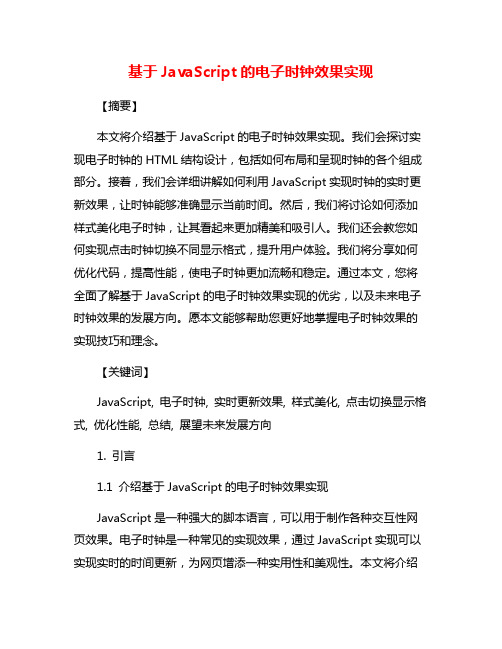
基于JavaScript的电子时钟效果实现【摘要】本文将介绍基于JavaScript的电子时钟效果实现。
我们会探讨实现电子时钟的HTML结构设计,包括如何布局和呈现时钟的各个组成部分。
接着,我们会详细讲解如何利用JavaScript实现时钟的实时更新效果,让时钟能够准确显示当前时间。
然后,我们将讨论如何添加样式美化电子时钟,让其看起来更加精美和吸引人。
我们还会教您如何实现点击时钟切换不同显示格式,提升用户体验。
我们将分享如何优化代码,提高性能,使电子时钟更加流畅和稳定。
通过本文,您将全面了解基于JavaScript的电子时钟效果实现的优劣,以及未来电子时钟效果的发展方向。
愿本文能够帮助您更好地掌握电子时钟效果的实现技巧和理念。
【关键词】JavaScript, 电子时钟, 实时更新效果, 样式美化, 点击切换显示格式, 优化性能, 总结, 展望未来发展方向1. 引言1.1 介绍基于JavaScript的电子时钟效果实现JavaScript是一种强大的脚本语言,可以用于制作各种交互性网页效果。
电子时钟是一种常见的实现效果,通过JavaScript实现可以实现实时的时间更新,为网页增添一种实用性和美观性。
本文将介绍基于JavaScript的电子时钟效果实现的方法及步骤,以帮助读者了解如何在网页中添加这一功能。
通过使用HTML、CSS和JavaScript的组合,我们可以设计一个简单而实用的电子时钟。
在HTML结构设计中,我们需要创建一个包含时、分、秒的不同部分的容器,并分别为它们赋予不同的id值,以便JavaScript可以获取并更新这些元素的时间信息。
利用JavaScript 实现时钟的实时更新效果是关键的一步,我们需要使用Date对象来获取当前的时间,并根据时间的变化来更新时钟的显示。
为了使电子时钟更加美观,我们可以通过添加样式来美化时钟的外观,例如改变字体颜色、大小、背景颜色等。
除了基本的实现功能之外,我们还可以通过JavaScript添加一些额外的交互性效果。
java中定时器设置时间
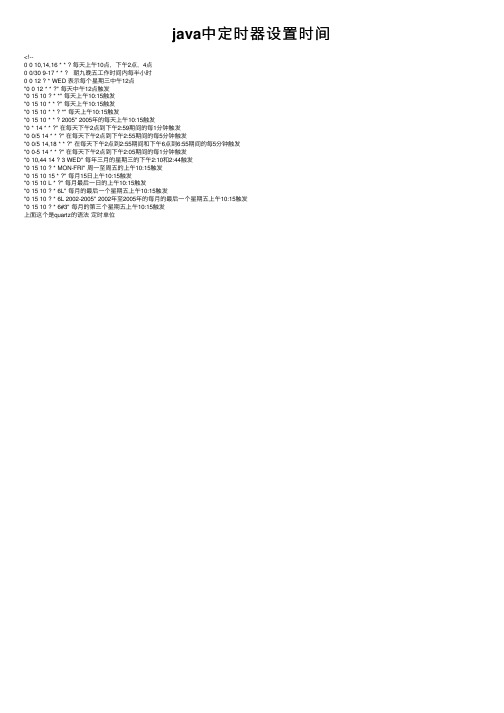
java中定时器设置时间<!--0 0 10,14,16 * * ? 每天上午10点,下午2点,4点0 0/30 9-17 * * ? 朝九晚五⼯作时间内每半⼩时0 0 12 ? * WED 表⽰每个星期三中午12点"0 0 12 * * ?" 每天中午12点触发"0 15 10 ? * *" 每天上午10:15触发"0 15 10 * * ?" 每天上午10:15触发"0 15 10 * * ? *" 每天上午10:15触发"0 15 10 * * ? 2005" 2005年的每天上午10:15触发"0 * 14 * * ?" 在每天下午2点到下午2:59期间的每1分钟触发"0 0/5 14 * * ?" 在每天下午2点到下午2:55期间的每5分钟触发"0 0/5 14,18 * * ?" 在每天下午2点到2:55期间和下午6点到6:55期间的每5分钟触发"0 0-5 14 * * ?" 在每天下午2点到下午2:05期间的每1分钟触发"0 10,44 14 ? 3 WED" 每年三⽉的星期三的下午2:10和2:44触发"0 15 10 ? * MON-FRI" 周⼀⾄周五的上午10:15触发"0 15 10 15 * ?" 每⽉15⽇上午10:15触发"0 15 10 L * ?" 每⽉最后⼀⽇的上午10:15触发"0 15 10 ? * 6L" 每⽉的最后⼀个星期五上午10:15触发"0 15 10 ? * 6L 2002-2005" 2002年⾄2005年的每⽉的最后⼀个星期五上午10:15触发"0 15 10 ? * 6#3" 每⽉的第三个星期五上午10:15触发上⾯这个是quartz的语法定时单位。
java 判断时间是否到达零点的方法

一、概述在编程过程中,经常需要对时间进行处理和判断。
在Java编程中,我们可能会遇到需要判断当前时间是否已经到达零点的情况。
本文将介绍在Java中判断时间是否到达零点的方法。
二、使用Calendar类进行时间操作在Java中,可以使用Calendar类来对时间进行操作。
我们可以获取当前的小时和分钟,然后判断是否已经到达零点。
1. 创建一个Calendar实例:```javaCalendar calendar = Calendar.getInstance();```2. 获取当前的小时和分钟:```javaint hour = calendar.get(Calendar.HOUR_OF_DAY);int minute = calendar.get(Calendar.MINUTE);```3. 判断是否已经到达零点:```javaif(hour == 0 minute == 0){// 已经到达零点System.out.println("已经到达零点");} else {// 尚未到达零点System.out.println("尚未到达零点");}```三、使用LocalTime类进行时间操作除了使用Calendar类外,还可以使用Java 8引入的新日期时间API 中的LocalTime类来进行时间操作。
我们可以使用LocalTime.now()获取当前时间,然后判断是否已经到达零点。
1. 使用LocalTime.now()获取当前时间:```javaLocalTime time = LocalTime.now();```2. 判断是否已经到达零点:```javaif(time.getHour() == 0 time.getMinute() == 0){// 已经到达零点System.out.println("已经到达零点");} else {// 尚未到达零点System.out.println("尚未到达零点");}```四、使用Joda-Time库进行时间操作除了使用Java 8的新日期时间API外,我们还可以使用Joda-Time 库来进行时间操作。
java及vue进度条实现方法
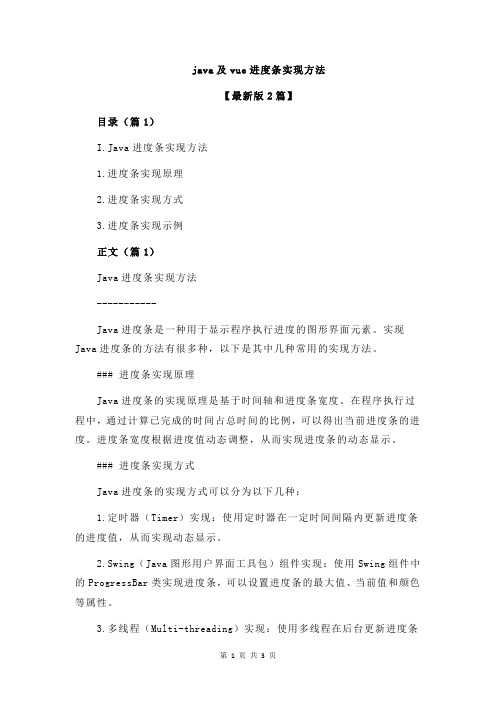
java及vue进度条实现方法【最新版2篇】目录(篇1)I.Java进度条实现方法1.进度条实现原理2.进度条实现方式3.进度条实现示例正文(篇1)Java进度条实现方法-----------Java进度条是一种用于显示程序执行进度的图形界面元素。
实现Java进度条的方法有很多种,以下是其中几种常用的实现方法。
### 进度条实现原理Java进度条的实现原理是基于时间轴和进度条宽度。
在程序执行过程中,通过计算已完成的时间占总时间的比例,可以得出当前进度条的进度。
进度条宽度根据进度值动态调整,从而实现进度条的动态显示。
### 进度条实现方式Java进度条的实现方式可以分为以下几种:1.定时器(Timer)实现:使用定时器在一定时间间隔内更新进度条的进度值,从而实现动态显示。
2.Swing(Java图形用户界面工具包)组件实现:使用Swing组件中的ProgressBar类实现进度条,可以设置进度条的最大值、当前值和颜色等属性。
3.多线程(Multi-threading)实现:使用多线程在后台更新进度条的进度值,从而实现动态显示。
目录(篇2)I.Java进度条实现方法1.什么是Java进度条2.Java进度条实现方法3.Java进度条应用场景正文(篇2)Java进度条是一种在应用程序中显示进度的图形界面元素。
它可以帮助用户了解程序执行过程中的进度,从而更好地控制程序的运行。
Java 进度条的实现方法有很多种,以下是其中几种常用的方法:1.使用Swing库中的JProgressBar组件JProgressBar是Swing库中的一个组件,可以用来创建进度条。
它提供了多种样式和大小选项,可以根据需要选择合适的样式。
使用JProgressBar实现进度条的步骤如下:(1)创建一个JProgressBar对象,并将其添加到容器中。
(2)设置JProgressBar的初始值和最大值。
(3)在需要更新进度条的地方调用setProgress方法,并传入当前进度值。
Java 实现数字时钟

Java 实现数字时钟时钟在人们的日常生活中很常见。
本实例介绍用Java事件实现简单的数字时钟功能。
(1)在【文件】菜单下选择【新建】|【类】命令,在弹出的对话框【新建Java类】中,创建ClockDemo.java文件,如图10-20所示。
图10-20 新建Java类(2)添加程序中要用到的程序包,代码如下所示。
import java.awt.*;import java.util.*;import javax.swing.*;(3)创建ClockDemo类的构造方法,设置窗口的大小、标题和显示时钟的字体,代码如下所示。
public ClockDemo(){super("数字时钟"); //调用父类构造函数setFont(new Font("Times New Roman",Font.BOLD,60)); //设置时钟的显示字体start(); //开始进程setSize(280,100); //设置窗口尺寸setVisible(true); //窗口可视setDefaultCloseOperation(JFrame.EXIT_ON_CLOSE); //关闭窗口时退出程序 }(4)添加时钟的开始、运行和停止的方法,代码如下所示。
(5)添加时钟paint()方法和对窗口进行初始化,全部代码如下所示。
elsetimeInfo+=second;g.setColor(Color.white); //设置当前颜色为白色Dimension dim=getSize(); //得到窗口尺寸g.fillRect(0,0,dim.width,dim.height); //填充背景色为白色g.setColor(Color.orange); //设置当前颜色为橙色g.drawString(timeInfo,20,80); //显示时间字符串}public static void main(String[] args){new ClockDemo();}}(6)执行上述代码,结果如图10-21所示。
桌面时钟代码
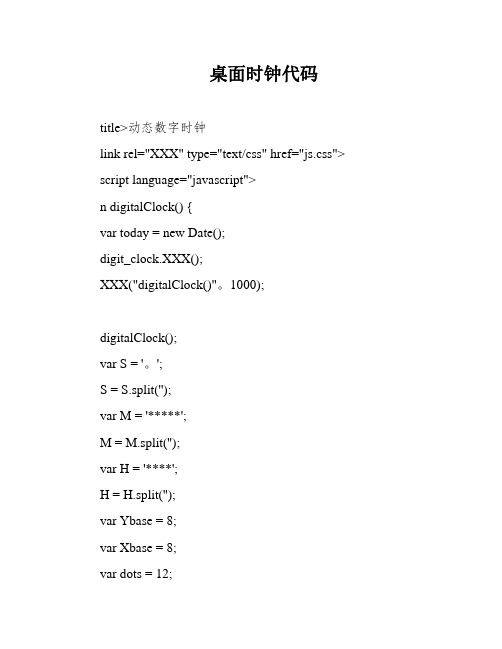
桌面时钟代码title>动态数字时钟link rel="XXX" type="text/css" href="js.css"> script language="javascript">n digitalClock() {var today = new Date();digit_clock.XXX();XXX("digitalClock()"。
1000);digitalClock();var S = '。
';S = S.split('');var M = '*****';M = M.split('');var H = '****';H = H.split('');var Ybase = 8;var Xbase = 8;var dots = 12;for (var i = 0.i < dots。
i++) {document.write('' + (i + 1) + '');for (i = 0.i < S.length。
i++) {document.write('');for (i = 0.i < M.length。
i++) {document.write('');for (i = 0.i < H.length。
i++) {document.write('');script>h1 align="center" id="digit_clock">body>html>删除该段落,因为它是一行代码,没有任何意义的描述XXX将分针的圆点放入各自的块中,id属性为m_dots for (i = 0.i < M.length。
时钟计时器使用Java语言和Swing界面库开发的小程序
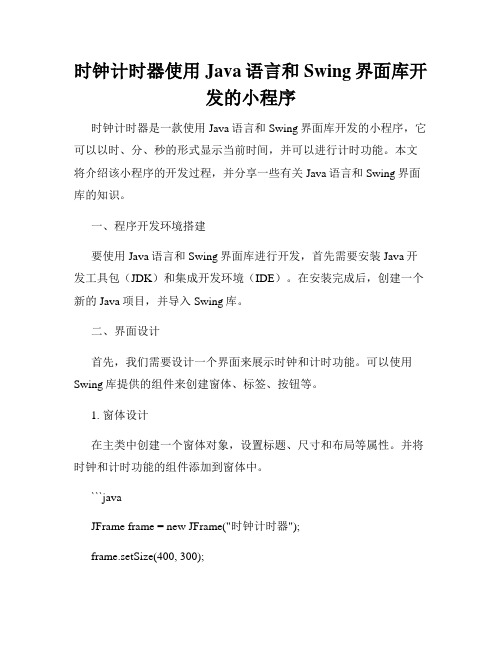
时钟计时器使用Java语言和Swing界面库开发的小程序时钟计时器是一款使用Java语言和Swing界面库开发的小程序,它可以以时、分、秒的形式显示当前时间,并可以进行计时功能。
本文将介绍该小程序的开发过程,并分享一些有关Java语言和Swing界面库的知识。
一、程序开发环境搭建要使用Java语言和Swing界面库进行开发,首先需要安装Java开发工具包(JDK)和集成开发环境(IDE)。
在安装完成后,创建一个新的Java项目,并导入Swing库。
二、界面设计首先,我们需要设计一个界面来展示时钟和计时功能。
可以使用Swing库提供的组件来创建窗体、标签、按钮等。
1. 窗体设计在主类中创建一个窗体对象,设置标题、尺寸和布局等属性。
并将时钟和计时功能的组件添加到窗体中。
```javaJFrame frame = new JFrame("时钟计时器");frame.setSize(400, 300);frame.setLayout(new BorderLayout());```2. 时钟设计使用标签组件来显示当前时间。
可以使用Java提供的日期和时间类(如Date和Calendar)来获取当前时间,并将其格式化后设置为标签的文本。
```javaJLabel clockLabel = new JLabel();frame.add(clockLabel, BorderLayout.CENTER);// 获取当前时间Date now = new Date();SimpleDateFormat sdf = new SimpleDateFormat("HH:mm:ss");String time = sdf.format(now);// 设置标签文本clockLabel.setText(time);```3. 计时功能设计为计时功能设计按钮组件,并添加监听事件。
在按钮的监听器中,通过定时器类(如Timer)来实现每秒更新计时器的功能。
妙用Java多线程机制实现多个时区时钟显示
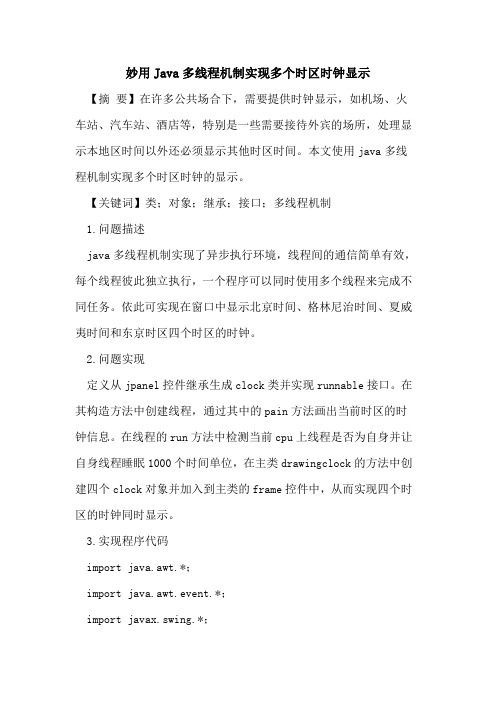
妙用Java多线程机制实现多个时区时钟显示【摘要】在许多公共场合下,需要提供时钟显示,如机场、火车站、汽车站、酒店等,特别是一些需要接待外宾的场所,处理显示本地区时间以外还必须显示其他时区时间。
本文使用java多线程机制实现多个时区时钟的显示。
【关键词】类;对象;继承;接口;多线程机制1.问题描述java多线程机制实现了异步执行环境,线程间的通信简单有效,每个线程彼此独立执行,一个程序可以同时使用多个线程来完成不同任务。
依此可实现在窗口中显示北京时间、格林尼治时间、夏威夷时间和东京时区四个时区的时钟。
2.问题实现定义从jpanel控件继承生成clock类并实现runnable接口。
在其构造方法中创建线程,通过其中的pain方法画出当前时区的时钟信息。
在线程的run方法中检测当前cpu上线程是否为自身并让自身线程睡眠1000个时间单位,在主类drawingclock的方法中创建四个clock对象并加入到主类的frame控件中,从而实现四个时区的时钟同时显示。
3.实现程序代码import java.awt.*;import java.awt.event.*;import javax.swing.*;import java.util.*;public class drawingclock {jframe frame;clock panell,panel2,panel3,panel4;public static void main(string args[]) { drawingclock dc=new drawingclock();dc.go();}public void go() {frame=new jframe(”时钟”);frame.getcontentpane().setlayout(null);panell=new clock(160,150,”北京时间”,0);//线程1画北京时间时钟frame.getcontentpane().add(panell);panel2=new clock(400,150,”格林威治时间”,-7);////线程2画北京时间时钟frame.getcontentpane().add(panel2);panel3=new clock(160,450,”东京时间”,1);//线程3画北京时间时钟frame.getcontentpane().add(panel3);panel4 = new clock(400,450,”夏威夷时间”,-10);//线程4画北京时间时钟frame.getcontentpane().add(panel4);frame.setdefaultcloseoperation(jframe.exit_on_close);frame.setsize(600, 650);frame.setvisible(true);}}class clock extends jpanel implements runnable {thread thr1=new thread(this);string text;int z;graphics graphics;date currentdate=new date(); //获取当前日期信息string lastdate=currentdate.tostring(); //获取当前日期信息的字符串形式int xcenter , ycenter; // 时钟的中心坐标值int radius=100;// 时钟的半径void drawcircle(){graphics.drawarc(xcenter-radius, ycenter-radius,radius*2, radius*2,0,360);for(int i=1;icalendar nowcal= calendar.getinstance();s=nowcal.get(calendar.second);//获取当前的秒值m=nowcal.get(calendar.minute);//获取当前的分钟值h=nowcal.get(calendar.hour);//获取当前的小时值h+=z;nowcal.set(calendar.hour,h);today+=nowcal.gettime().tostring();//获取当前秒针、分针和时针的末端坐标值xs=(int)(math.cos(s * math.pi / 30 - math.pi / 2) *(radius-10) + xcenter);ys=(int)(math.sin(s * math.pi / 30 - math.pi / 2) *(radius-10) + ycenter);xm=(int)(math.cos(m * math.pi / 30 - math.pi / 2) * (radius-40) + xcenter);ym=(int)(math.sin(m * math.pi / 30 - math.pi / 2) * (radius-40) + ycenter);xh=(int)(math.cos((h*30+m/2) * math.pi / 180 - math.pi / 2) * (radius-60)+ xcenter);yh=(int)(math.sin((h*30+m/2) * math.pi / 180 - math.pi / 2) * (radius-60)+ ycenter);//清除界面,显示日期信息,并画秒针、分针和时针g.clearrect(xcenter-100, ycenter+radius+2,200,30);g.drawstring(today, xcenter-100, ycenter+radius+20);g.drawline(xcenter, ycenter, xs, ys);g.drawline(xcenter, ycenter, xm, ym);g.drawline(xcenter, ycenter, xh, yh);}public void run() {thread me = thread.currentthread();while ((thr1== me)) {//若是本线程则休眠1000个单位后刷新try {thread.currentthread().sleep(1000);//当前线程休眠1秒} catch (interruptedexception e) {}repaint();//重画时钟}}public clock(int x,int y,string s,int zone){z=zone;text=s;xcenter=x;ycenter=y;setsize(600,800);thr1.start();//启动线程}}4.结语本程序能准确显示四个时区的时间信息,但界面美观程度不够。
java中自动生成法定节假日的cron表达式

一、概述在日常的软件开发中,经常会遇到需要自动生成法定节假日的cron表达式的情况。
而在Java中,我们可以通过一些开源的库来实现这一功能。
本文将介绍如何在Java中使用开源库来自动生成法定节假日的cron表达式,以方便开发人员在编写定时任务时能够考虑到法定节假日的影响。
二、什么是cron表达式在介绍如何自动生成法定节假日的cron表达式之前,我们首先需要了解什么是cron表达式。
Cron表达式是一个字符串,它可以被用来表示一段时间间隔(如:每天、每个月的某一天、每小时等)。
它可以被用于定时任务调度,常见于Linux系统的定时任务配置中。
Cron表达式由6或7个空格分隔的时间字段组成,依次是:秒、分、时、日、月、周几和年(可选)。
其中,用符号“*”来表示匹配任意值。
三、Java中的cron表达式生成工具在Java中有一些开源的库可以帮助我们生成cron表达式,比如Quartz、Spring Framework等。
其中,Quartz是一个非常优秀的定时任务调度框架,它提供了丰富的API,可以方便地生成各种类型的cron表达式。
Spring Framework也提供了对Quartz的集成,可以更加方便地在Spring应用中使用Quartz来实现定时任务的调度。
四、法定节假日对定时任务的影响在实际的软件开发中,我们经常会遇到需要在法定节假日暂停或者调整定时任务的情况。
在某些特殊的节假日,我们希望定时任务可以暂停执行,以免对系统产生影响。
而在一些节日的前后,我们可能需要调整定时任务的执行时间,以适应节日期间的业务需求。
五、自动生成法定节假日的cron表达式为了应对法定节假日对定时任务的影响,我们可以利用开源库来自动生成法定节假日的cron表达式。
在Java中,可以使用一些开源的库来实现这一功能。
可以使用Quartz的API来动态生成法定节假日的cron表达式。
也可以结合一些公共的节假日数据源来自动生成法定节假日的cron表达式。
- 1、下载文档前请自行甄别文档内容的完整性,平台不提供额外的编辑、内容补充、找答案等附加服务。
- 2、"仅部分预览"的文档,不可在线预览部分如存在完整性等问题,可反馈申请退款(可完整预览的文档不适用该条件!)。
- 3、如文档侵犯您的权益,请联系客服反馈,我们会尽快为您处理(人工客服工作时间:9:00-18:30)。
g.setColor(Color.white);
g.fillRect(180, getHeight()-25, 30,15);
g.setColor(Color.black);
g.drawString(""+minute, 190,getHeight()-15 );
public ClockAnimation()
{
add(clock);
Timer timer=new Timer(1000,new TimerListener());
timer.start();
}
private class TimerListener implements ActionListener
g.drawString("Hour", 60, getHeight()-15);
g.setColor(Color.white);
g.fillRect(90, getHeight()-25, 30,15);
g.setColor(Color.black);
g.drawString(""+hour, 95,getHeight()-15 );
g.drawString("Second", 230, getHeight()-15);
g.setColor(Color.white);
g.fillRect(280, getHeight()-25, 30,15);
g.setColor(Color.black);
g.drawString(""+second, 290,getHeight()-15 );
g.setColor(Color.red);
g.drawLine(xCenter, yCenter, xSecond, ySecond);
int mLength=(int)(clockRadius*0.65);
int xMinute=(int)(xCenter+mLength*Math.sin(minute*(2*Math.PI/60)));
JFrame frame=new ClockAnimation();
frame.setTitle("DisplayClock");
frame.setSize(400,400);
frame.setDefaultCloseOperation(JFrame.EXIT_ON_CLOSE);
g.setColor(Color.green);
g.drawLine(xCenter, yCenter, xHour, yHour);
g.setColor(Color.black);
g.drawRect(20, getHeight()-35, getWidth()-7
public int getMinute()
{
return minute;
}
public void setMinute(int minute)
{
this.minute=minute;
repaint();
}
public int getSecond()
g.setColor(Color.BLACK);
g.drawOval(xCenter-clockRadius, yCenter-clockRadius, 2*clockRadius,2*clockRadius);
g.drawString("12", xCenter-5, yCenter-clockRadius+12);
int clockRadius=(int)(Math.min(getWidth(), getHeight())*0.3);
int xCenter=getWidth()/2;
int yCenter=getHeight()/2;
g.setColor(Color.black);
g.drawRect(20, 20, getWidth()-70,getHeight()-70);
//ClockAnimation.java
package p1;
import javax.swing.*;
import java.awt.*;
import java.awt.event.*;
public class ClockAnimation extends JFrame
{
private StillClock clock=new StillClock();
public class StillClock extends JPanel
{
private int hour;
private int minute;
private int second;
public StillClock()
{
setCurrentTime();
}
public StillClock(int hour,int minute,int second)
int yMinute=(int)(yCenter-mLength*Math.cos(minute*(2*Math.PI/60)));
g.setColor(Color.blue);
g.drawLine(xCenter, yCenter, xMinute, yMinute);
int hLength=(int)(clockRadius*0.5);
frame.setLocationRelativeTo(null);
frame.setVisible(true);
}
}
//StillClock.java
package p1;
import java.util.*;
import javax.swing.*;
import java.awt.*;
}
public void setCurrentTime()
{
Calendar calendar=new GregorianCalendar();
this.hour=calendar.get(Calendar.HOUR_OF_DAY);
this.minute=calendar.get(Calendar.MINUTE);
int sLength=(int)(clockRadius*0.8);
int xSecond=(int)(xCenter+sLength*Math.sin(second*(2*Math.PI/60)));
int ySecond=(int)(yCenter-sLength*Math.cos(second*(2*Math.PI/60)));
{
this.hour=hour;
this.minute=minute;
this.second=second;
}
public int getHour()
{
return hour;
}
public void setHour(int hour)
{
this.hour=hour;
{
public void actionPerformed(ActionEvent e)
{
clock.setCurrentTime();
clock.repaint();
}
}
public static void main(String[] args)
{
this.second=calendar.get(Calendar.SECOND);
}
public Dimension getPreferredSize()
{
return new Dimension(200,200);
}
}
g.drawString("9", xCenter-clockRadius+3, yCenter+5);
g.drawString("3", xCenter+clockRadius-10,yCenter+3);
g.drawString("6", xCenter-3, yCenter+clockRadius-3);
int xHour=(int)(xCenter+hLength*Math.sin((hour%12+minute/60.0)*(2*Math.PI/12)));
int yHour=(int)(yCenter-hLength*Math.cos((hour%12+minute/60.0)*(2*Math.PI/12)));
{
return second;
}
public void setSecond(int second)
{
this.second=second;
repaint();
}
protected void paintComponent(Graphics g)
{
super.paintComponent(g);
